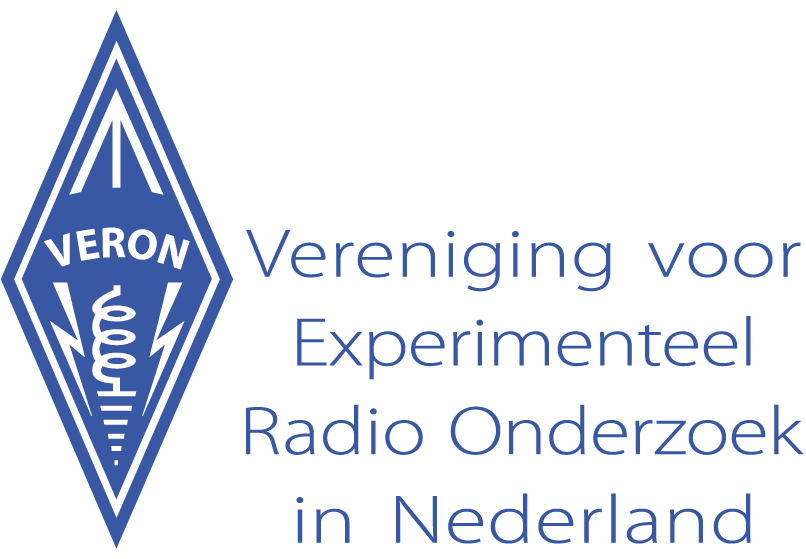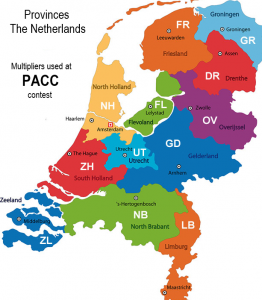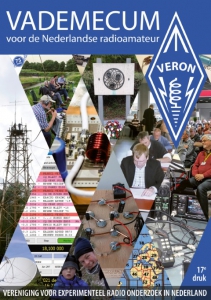FAQ betreffende de PACC regels
Algemene vragen
Waar vind ik de PACC regels?
Onder de knop download regels
Wat is de maximale deelname tijd?
24 uur van zaterdag 1200 UTC tot zondag 1200 UTC, houd rekening met de lokale tijd. Zorg dat je PC op de juiste tijd is ingesteld en voorkom daarmee dat het log geen tijdverschil heeft met de UTC-tijd.
Mag een operator die deelneemt aan een multistation ook vanuit huis een eigen log indienen?
Ja dat kan, een operator mag deelnemen aan multistation en daarna thuis meedoen en ook een eigen log indienen.
Hoe kom ik in aanmerking voor een vaantje?
Iedere deelnemer die een log instuurt en in de cabrillo log header een geldig adres opgeeft krijgt op dat adres een vaantje toegestuurd. Bij multi-stations moet het juiste aantal deelnemers opgeven worden om zo het juiste aantal vaantjes toegestuurd te krijgen.
Kan ik ook een certificaat van deelname ontvangen?
Ja, dit is voor elk deelnemend station mogelijk zie hiervoor de knop CERTIFICAAT
Vooralsnog alleen mogelijk in het jaar van deelname.
Ik wil deelnemen aan het afdelingsklassement?
Dit geldt voor VERON afdelingen. Afdelingsnummer (niet QSL regio) moet worden vermeld in het Cabrillo log bij de “CLUB:” header, bijvoorbeeld “CLUB: 35” of “CLUB: 01 ALKMAAR” . De afdelingsscore is de som van de single- en SWL-operator scores van één afdeling.
Vragen betreffende het log
Moet ik dupes gaan loggen?
Ja dupes altijd loggen. De contest robot zal dit correct weergeven.
Moet ik cabrillo V2 of V3 gebruiken?
De robot accepteert beide cabrillo formaten, zowel Cabrillo V2 als Cabrillo V3. Voorbeelden staan onder de knop LOGS.
Ik haal de deadline voor het insturen van het log niet?
Laat de contest organisatie voor het einde van de deadline weten wat de reden is. De contestmanager zal hierover een beslissen nemen.
Ik log op papier wat moet ik doen?
Wij raden af om op papier te loggen. Controle op het log wordt bemoeilijkt.
U kunt het log insturen per post naar het adres vermeld in de PACC regels.
Operator vragen
Mag ik gebruik maken van internet, DXclusters, skimmers etc?
In de PACC is het toegestaan om zowel van clusters, skimmers, etc. gebruik te maken. Alle categorieën zijn assisted.
Kan ik mijn scores op een live scorebord plaatsen?
Ja dit kan en mag maar dat bepaalt elke deelnemer zelf. Het is erg leuk om te zien hoe de concurrentie het doet. Diverse logging programma’s hebben hiervoor voorzieningen. Het bekendste live scoreboard is: contestonlinescore.com.
Als ik multimode ben mag ik dan een station in zowel SSB als CW werken op dezelfde band?
Sinds 2016 geldt dat mixed mode stations zowel in SSB als in CW op dezelfde band gewerkt mag worden. Als dit station ook een multiplier is dan telt de multiplier twee keer.
Multi Operator Single Transmitter (MOST) - FAQ
This section covers many questions we receive about the Multi-Single (MULTI-ONE) category.
EXPLANATION:
This category permits up to two signals (one RUN and one MULTPLIER) to be transmitted at the same time, but ONLY if each signal is on a different band AND with the following limitations.
The RUN SIGNAL may be transmitted on any band and may contact all other stations. The RUN signal must remain on the band for at least 10 minutes. The ten minute period begins when the first QSO (contact) on that band is made. A RUN SIGNAL may not be transmitted on a “new band” until the 10 minute period has been met or exceeded. The RUN signal will be designated with a “0” in the transmitter column of the Cabrillo log.
The MULTIPLIER SIGNAL may be transmitted on any band, but may only contact another station if, and only if, it is a new multiplier on that band. The MULTIPLIER SIGNAL may only call other stations. The MULTIPLIER SIGNAL may not request or attract any QSO by calling CQ, QRZ, TEST, etc. The MULTIPLIER SIGNAL must remain on one band for at least 10 minutes. The ten minute period begins when the first QSO with a new multiplier on that band is made. A MULTIPLIER SIGNAL may not be transmitted on a “new band” until the 10 minute period for the MULTIPLIER SIGNAL has been met or exceeded. The MULTIPLIER SIGNAL will be designated with a “1” in the transmitter column of the Cabrillo log.
The designation of “0” (runner) or “1” (multiplier) is not assigned to an actual physical radio, although that is possible. The signal designation of “0” and “1” is a functional designation. Rig “A” or “B” (or “C,” etc., if more than 2 radios) can be assigned either “0” or “1” according to its function (role) at the time of the QSO.
All QSOs must be logged immediately upon completion of the QSO.
Q: The category name is “Multi-Operator, Single Transmitter,” but you are saying that we can use more than one transmitter?
Yes, that is correct. The ability to run stations and hunt for multipliers at the same time is one of the reasons the CQ WW Multi-Single category is so popular.
Q: You have talked about the “ten minute rule” in both the RUN SIGNAL and the MULTIPLIER SIGNAL sections. Is there one “ten minute rule” that applies to both signals?
There are two separate and independent ten minute rules. One ten minute rule applies to the RUN SIGNAL and a separate, independent ten minute rule applies to the MULTIPLIER SIGNAL.
Q: When does the 10 minute clock start when changing to a new band?
The 10 minute clock starts with the first QSO on a new band. QSOs must be logged immediately upon completion of the QSO.
Q: What if we QSY to a new band to call a needed multiplier but it takes 2 minutes to break the pileup? Does the clock start when we first transmit on the new band or when we make the QSO?
The clock always starts with the first logged QSO. QSOs must be logged immediately upon completion of the QSO.
Q: What if we QSY from 20m to 10m, but do not make a QSO on 10m. Does the clock reset when we QSY to 10m?
No. The clock starts only when you make a QSO on the new band. If you QSY to another band, but do not make a QSO, then the clock does not reset.
Q: May we transmit on a new band before the 10 minute period, as long as we do not make a QSO on the new band before 10 minutes?
No. You may not transmit on the new band until after you are allowed to QSY to the new band. You must always follow the 10 minute rules.
Q: The clock on our logging software only shows whole minutes (no seconds). A QSO logged at 14:00:01 shows as 14:00. A QSO logged at 14:00:58 also shows as 14:00 in the log. Both look to be the same time. How can we accurately determine the timing for the 10 minute period?
Q: What should we do if we are using more than one computer and the computer clocks are out of sync with each other? How can we accurately determine the 10 minute period?
It is the entrant’s responsibility to ensure that his/her clocks are in synchronization with a time standard (such as WWV, www.time.gov, Winbox tools, etc.) and with each other.
Q: What should we do if our RUN SIGNAL moves to a new band and starts to invite contacts (call CQ, QRZ, TEST, “my call,” etc.) before the 10 minutes are up?
Any transmission before the 10 minute period is against the rules. If you have not yet made a contact on the new band, stop immediately and wait for the 10 minute period. If you have made some QSOs, those contacts are in violation of the 10 minute rule and they will be removed without penalty. Calling CQ “early” (before the ten minute period) and intentionally not logging any callers (in order to take/hold a frequency) or changing times to be time compliant is a violation of the rules and may result in being disqualified. In all cases, you should log every QSO that you make regardless of time violation issues.
Q: What should we do if our MULTIPLIER SIGNAL moves to a new band and completes the QSO with the needed multiplier, but it is before the allowed 10 minute period? We do not want to lose the multiplier!
You have violated the 10 minute rule. You may contact the same station again, on the same band, when you have complied with the 10 minute rule. If you do work them again, be sure to log them again. If you work them twice (once in violation and once in compliance with the 10 minute rule), be sure to log both of the QSOs. Mark the first contact (the one in violation of the 10 minute rule) with X-QSO. This will give credit to the other station.
Q: Is there a limit on the number of times we can use X-QSO in our log?
X-QSO is intended for correction of occasional mistakes that happen during the contest. If the committee decides that X-QSO is being used to avoid the 10 minute rule the log will be subject to possible reclassification or other committee action, as deemed appropriate. For example, CQing on a new band with the intent of X-QSOing non-multipliers that call you is not allowed.
Q: Can we use a third band to search for possible multipliers and ask them to move to either the RUN or MULTIPLIER band?
No. A station in the Multi-Single category may not TRANSMIT on more than two bands at any time. The bands in use must be in compliance with the RUN and MULTIPLIER 10 minute rules.
Q: Can we use two or more radios on the same band to make QSOs?
When two or more transmitters are present on the same band, a hardware device MUST be used to prevent more than one signal at any one time. It is not permitted to request or solicit QSOs (e.g., call CQ) on more than one frequency at a time. The second interlocked station on the band should only be calling stations and must change frequencies after each QSO.
Hoe werkt de 10 minuten regel in de Multi Operator Two Transmitter (MO2T)?
Er mag per station/zender niet vaker van band gewisseld worden dan eens per 10 minuten. Ook niet als het een multiplier betreft. Het is belangrijk om bij het installeren van de contest logging software aan te geven welke radio gebruikt wordt bv radio-1 = 0 en radio-2 = 1. Gebruik hiervoor de Cabrillo standaard. Tip: zorg ervoor dat de computers op dezelfde tijd zijn ingesteld.
Welke multipliers zijn er te werken voor de niet PA deelnemers?
Niet-Nederlandse (PA) stations (incl. SWLs): één multiplier voor elke Nederlandse provincie per band per mode.
De Nederlandse provincie afkortingen zijn:
DR= Drenthe NB = Noord-Brabant
FL= Flevoland NH = Noord-Holland
FR= Friesland OV = Overijssel
GD= Gelderland UT = Utrecht
GR= Groningen ZH = Zuid-Holland
LB= Limburg ZL = Zeeland





